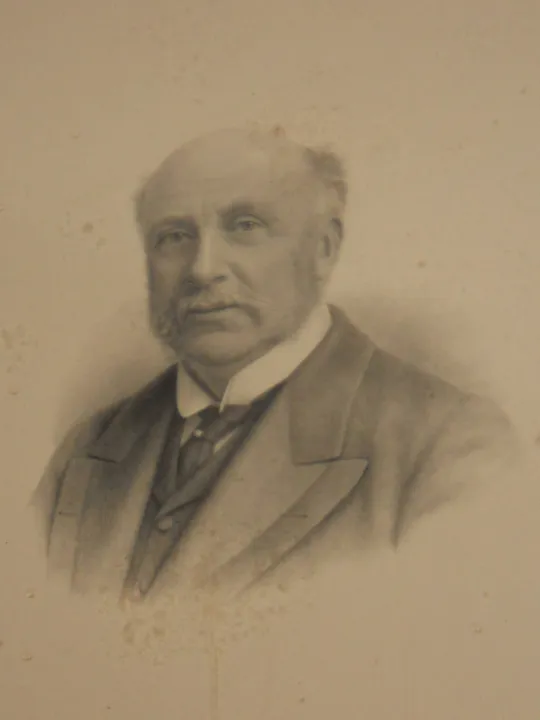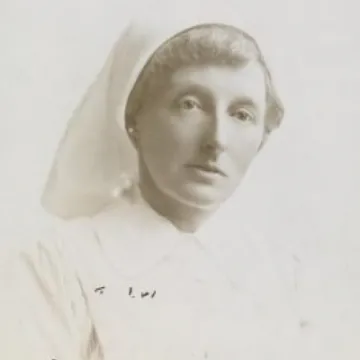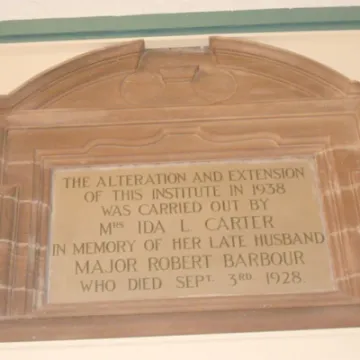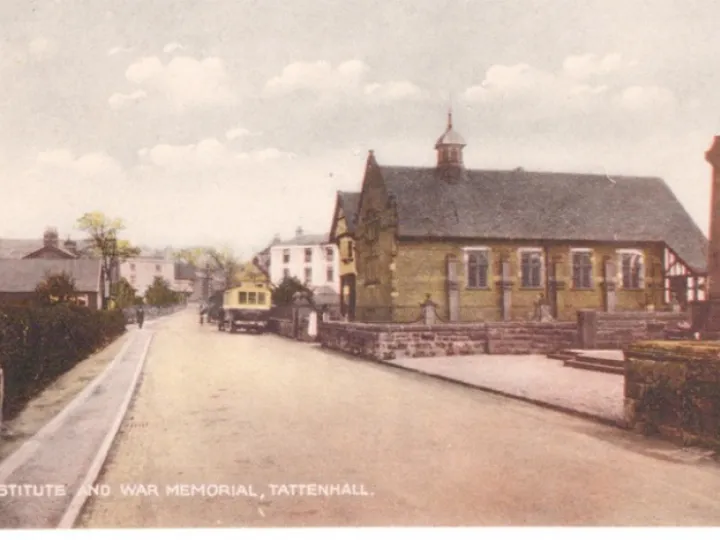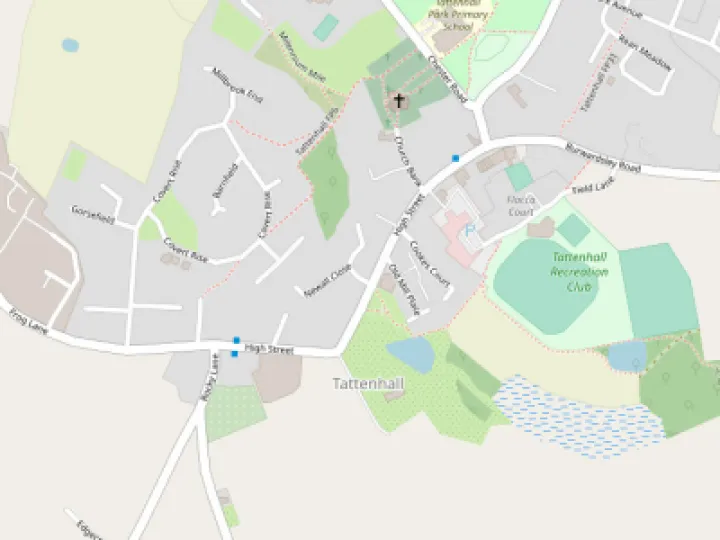The History of the Barbour Institute
We reproduce below research undertaken by Terri Hull concerning the history of the Barbour Institute. Terri manages the Tattenhall Local History Website and she worked closely with the Bolesworth Estate in the production of this piece of work – find out more exciting details about life in Tattenhall at the following http://www.tattenhallhistory.co.uk/
The building was erected by George Barbour in memory of his Mother, Janet Andrew Barbour, who died in 1896 and in whose 'Will' it was specified 'To the parish of Tattenhall, for the purpose of providing a public room for parish purposes, £500 to be laid out in such manner and to be vested in such persons as my son George shall determine'.
The Malpas Deanery Magazine of September 1898 devoted several column inches to the 'opening of the new Barbour Institute'. It appears that the opening ceremony was one of two simultaneous events in Tattenhall during the summer of 1898, the other being 'the long-talked-of Bazaar in aid of the building fund of the National School'.
The official opening of the Barbour Institute is described as follows:
'visitors arriving on the afternoon of Wednesday 27 July 1898 heard the Church bells ringing and found the road-way gay with fluttering flags and streamers; they were ushered into the large Hall. At three o'clock the Marchioness of Cholmondeley came on to the platform, accompanied by Lady Lettice Cholmondeley (and) Mr and Mrs Barbour ... After a short religious service, conducted by the Rector, especially intended to dedicate the new Institute to good and useful purposes, the Rev CL Arnold said he felt it an honour and pleasure to make the first speech in the Hall. He heartily thanked Mr Barbour, in the name of the whole Parish for the munificent manner in which he had carried out his mother's wish'.
Mr Barbour in his vote of thanks said 'that if the Institute were well used for the mental, moral and social benefit of the neighbourhood, he should feel repaid for the expense he had incurred'.
Interestingly, in the October edition of the Malpas Deanery Magazine 1898 a further page is devoted to the Barbour Institute in which a 'virtual tour' of the building is undertaken. A 'Reading Room' (the first portion to be opened to the public) is described 'with a charming bay window adorned with scrolls of green glass, having a bright look out over the road and opposite fields'.
As early as 1908 the Institute was described in RO Orton's 'Tattenhall – Sketches of the village of that name near Chester', as 'a very fine building, between that portion of the High Street known as the "New Road" and the Mill Pool'.
'On the outside, facing the road, is a fine carving, in stone, of the armorial bearings of the family of Barbour'.
'Arms: Argenta St. Andrew's cross between a garb in chief, two escallops in the flaunches, and another in base azure'.
'Motto: "Nihil nisa cruce" ("with nothing but the cross")'.
During The Great War 1914-1918 the Institute was used as an Army Hospital and in a document dated March 1915 there is a direct reference to 'giving up the buildings for use as a Military Hospital'. There are several photographs and paintings of the Institute in use as a hospital and other photographs which confirm that it was surrounded by a wall and railings, the latter being subsequently removed for use as scrap during WWII.
The extract below is from the Bolesworth Estate Scrapbook of November 1914. Within the pages of the Scrapbook is an article from 'The Observer' which makes reference to the Barbour Institute as a Hospital:
'Providing accommodation for 10 patients. The large hall is converted into a ward and the reading room is utilised for dining and recreation. The rooms on the upper floor being occupied by the nursing staff. The work is carried on upon an entirely voluntary basis and many ladies and gentlemen in the district have readily co-operated by their financial aid and personal services for the welfare of the patients. Under the superintendence of Mrs Edith Marguerite Wignall there is a staff of proficient nurses including Miss J Barbour and Miss I Barbour (presumably these were 2 of George Barbour's daughters, namely Janet and Isabel Barbour). The doctors in attendance are Dr TB Brierley and Dr WH Wigham. Mr George Barbour lent four motor cars to convey the wounded men from Fazackerley military hospital'.
When George Barbour died in November 1919 aged 78, his obituary in the Chester Courant also made reference to the Barbour Institute as follows:
'In the life of the village of Tattenhall, Mr Barbour showed his interest in many ways, notably the gift of the handsome Institute ... bearing his name ... In this Institute Mr Barbour always took a lively interest and it has proved a much appreciated centre of social enjoyment'.
In July 1937, Chester Architects H. Beswick and Son of 19 Newgate Street, drew up plans and specifications for extensions to the building. This involved demolition of a section of the main structure at the rear, of several internal walls and of the boundary wall adjoining Messrs Cooke lean to shed to sill level. The specifications are insistent that there would be a considerable quantity of suitable old material for re-use and that it was to be noted that this material was to be re-used in preference to new material at elevations facing the Main Road and Mill Lane. The use of the Ruabon bricks, inparticular, receives mention. Similarly, the quality of the materials used in the extension is specified, stating that 'the oak for the half timber work is to be the best quality English oak felled at least 4 years and is to be thoroughly seasoned'. The alteration and extension of the Institute was authorised by Mrs Ida Lavington Carter* in memory of her late husband, Major Robert Barbour (*Ida Lavington Barbour remarried in 1932, following the death of Major Robert Barbour in 1928). The commemorative stone in recognition of the extension works is located within the Barbour Institute and is shown to the right.
Interestingly, Lieutenant Robert James Barbour, son of Major Robert Barbour and Ida Lavington Barbour of Bolesworth Estate, was killed in action during WWII. He died on 11 February 1944 aged 23 and served with the Welsh Guards. He is buried at Cassino War Cemetery, Italy. His name is also listed on the Bickerton War Memorial which is to be found in the grounds of Holy Trinity Church. In context, the Allies invaded the Italian mainland on 3 September 1943 (the invasion coinciding with an armistice made with the Italians who then re-entered the war on the Allied side). Progress through southern Italy was rapid despite stiff resistance but by the end of October, the Allies were facing the German winter defensive position known as the 'Gustav Line' which stretched from the river Garigliano in the west to the Sangro in the east. Initial attempts to breach the western end of the line were unsuccessful. Operations in January 1944 landed troops behind the German lines at Anzio but defences were well organised and a breakthrough was not actually achieved until 18 May 1944, when Cassino was finally taken. It was during this offensive that Lieutenant Robert James Barbour died.
Particular thanks to 'Bolesworth Estate' in allowing access to their Archival Records
Contact Us
info@barbourinstitute.com
01829 771649
The Barbour Institute
High Street
Tattenhall
CH3 9PX
